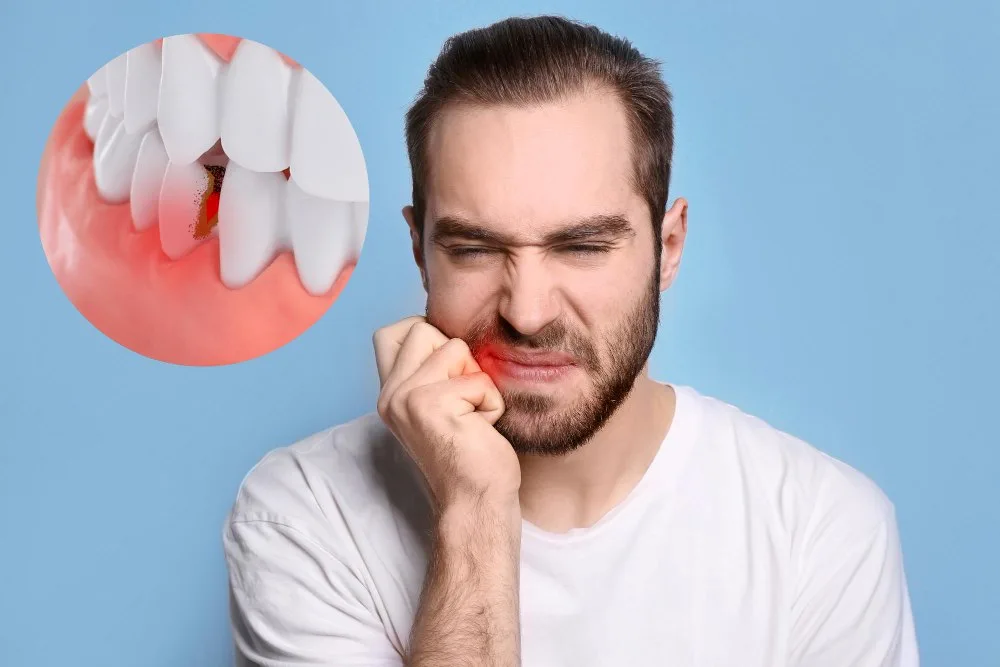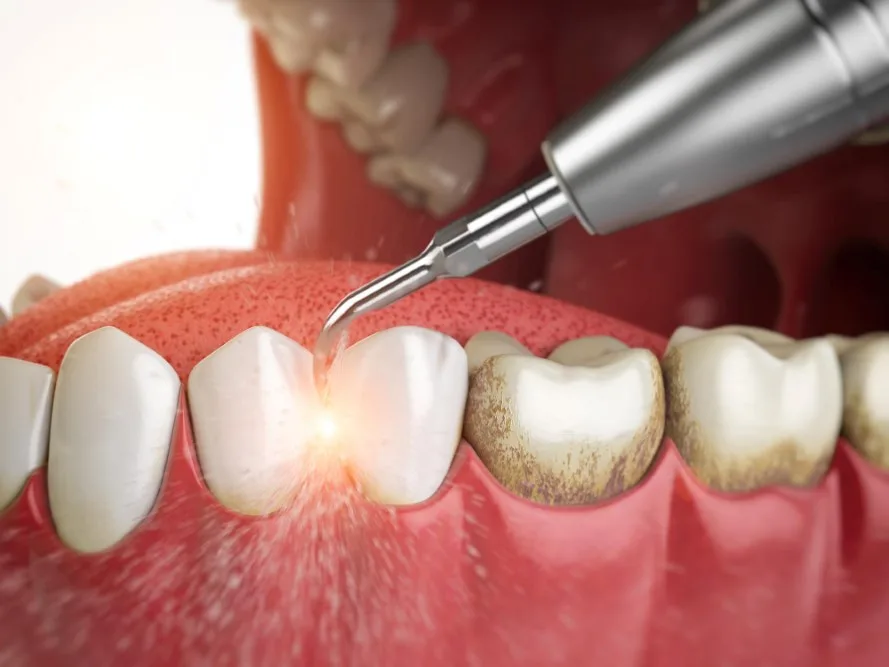Calculus on Teeth (Dental Tartar): A Hidden Threat
Calculus on teeth (Dental Tartar) is more than just a cosmetic concern — it’s a hardened bacterial buildup that can lead to serious dental problems if ignored. Often starting as soft plaque, calculus forms when plaque isn’t removed in time and mineralizes on the surface of teeth, especially around the gumline. Unlike plaque, calculus can’t be brushed or flossed away at home. It requires professional dental cleaning and, in many cases, specialized tools to remove.
If left untreated, calculus on teeth creates a rough surface that harbors more bacteria, irritates the gums, and leads to inflammation, bad breath, gum disease, and even tooth loss. Understanding what it is, how it forms, and how to prevent it is key to protecting both your teeth and overall health.
This guide will walk you through what calculus on teeth (Dental Tartar) really means, how it’s different from plaque, why certain people are more prone to it, and what you can do to stop it before it causes long-term harm.
Calculus on Teeth (Dental Tartar): What It Is and How It Forms
Calculus on teeth (Dental Tartar) is the hardened form of dental plaque — a soft, sticky film of bacteria that naturally forms on teeth throughout the day. When plaque is not consistently removed through brushing and flossing, it begins to absorb minerals from saliva. This mineralization process causes it to harden and become tartar, also known as dental calculus.
Unlike plaque, which is colorless and soft, calculus can appear yellow, brown, or even black, especially around the gumline and between teeth. It creates a rough surface that attracts even more plaque and bacteria, accelerating gum inflammation and increasing the risk of periodontal disease.
Once calculus forms, it bonds tightly to the enamel and root surfaces of the teeth. It cannot be removed by brushing or using dental floss. Only a dental professional can safely remove it using specialized tools during a cleaning appointment.
Understanding how calculus forms is important because it shows how small lapses in oral hygiene can lead to serious consequences. Daily brushing, flossing, and regular dental visits are essential to prevent its development and protect your teeth and gums over time.
Calculus on Teeth (Dental Tartar) vs Plaque: What’s the Difference?
Many people use the terms “plaque” and “tartar” interchangeably, but they represent two different stages of bacterial buildup in the mouth. Plaque is a soft, colorless film that forms on teeth when bacteria in the mouth mix with food particles and saliva. It begins to form within hours of eating and can be removed through regular brushing and flossing.
Calculus on teeth (Dental Tartar), however, is plaque that has not been removed and has hardened over time. This mineralized form sticks tightly to the enamel and can only be removed with professional dental tools. Calculus on teeth tends to build up near the gumline and between teeth, where brushing may not always reach effectively.
The key difference lies in removability and severity. Plaque is reversible and manageable at home with good oral hygiene. Once it turns into calculus, it becomes a risk factor for gum disease, cavities, and bad breath.
Distinguishing between the two helps patients understand the importance of consistent oral hygiene. While plaque control is within reach for most people, avoiding calculus requires both home care and regular professional cleanings.
Who’s More Prone to Dental Tartar Formation? (Risk Factors Explored)
While calculus on teeth (Dental Tartar) can affect anyone, certain individuals are more prone to developing it. Several biological and lifestyle-related risk factors contribute to a higher likelihood of tartar accumulation.
People with poor oral hygiene routines are naturally at greater risk, especially if brushing and flossing are inconsistent or ineffective. Smokers are particularly vulnerable due to changes in saliva composition and reduced immune response in the gums, which promotes bacterial buildup.
Genetics also play a role. Some individuals produce more minerals in their saliva, accelerating the mineralization of plaque into calculus. Others may have misaligned or crowded teeth that make cleaning difficult, allowing plaque to remain undisturbed and harden over time.
Those with dry mouth, caused by medication or systemic conditions, have less saliva to naturally wash away food particles and neutralize acids. Diets high in sugar or starch can feed bacteria that form plaque more quickly.
Knowing these risk factors allows individuals and dental professionals to create personalized prevention plans and schedule cleanings accordingly. High-risk patients may need more frequent visits and additional tools, such as interdental brushes or prescription rinses, to keep calculus at bay.
Home Care Tips to Prevent Hard Deposits on Your Teeth

Preventing the formation of calculus on teeth (Dental Tartar) starts with effective home care. While professional cleanings are essential for removing calculus on teeth once it forms, preventing it in the first place depends on daily habits.
Brushing your teeth twice a day with fluoride toothpaste is the foundation of good oral health. Use a soft-bristled toothbrush and be sure to reach all tooth surfaces — especially along the gumline and between teeth. Electric toothbrushes are often more effective at removing plaque, particularly for people with limited dexterity or orthodontic appliances.
Flossing once a day is critical, as it removes plaque between teeth where brushes can’t reach. Water flossers and interdental brushes can also help disrupt plaque in hard-to-reach areas.
Using an antimicrobial or anti-tartar mouthwash can reduce bacterial growth and slow down mineralization. Additionally, reducing sugary snacks and drinks limits the food source for plaque-causing bacteria.
While home care can’t remove existing calculus on teeth, it is the best defense against its formation. When done consistently and correctly, these practices minimize the need for invasive procedures and preserve both teeth and gum health.
Calculus on Teeth (Dental Tartar): Why Brushing Alone Isn’t Enough
While brushing is essential for daily plaque removal, it is not enough to prevent the formation of calculus on teeth (Dental Tartar). Calculus on teeth begins to form when plaque is left undisturbed for as little as 24 to 72 hours. Once mineralized, it cannot be removed with a toothbrush alone.
Standard toothbrush bristles are designed to sweep away soft plaque, not hardened deposits. In fact, brushing over tartar-covered areas can be misleading — the tooth may feel clean, but the buildup remains. This false sense of security often leads people to delay professional cleanings.
Additionally, brushing may not reach the tight spaces between teeth or deep along the gumline, where calculus on teeth often accumulates first. That’s why flossing and interdental cleaning are equally important components of oral care.
Even those with excellent brushing habits will eventually develop calculus on teeth if professional cleanings are skipped. Dental hygienists use specialized instruments like scalers and ultrasonic devices to break and remove calculus without damaging enamel or gums.
Understanding the limitations of brushing reinforces the importance of a complete oral hygiene strategy — one that includes flossing, rinsing, diet awareness, and regular dental visits.
Calculus on Teeth (Dental Tartar): How Often Professional Removal Is Needed
The frequency of professional removal for calculus depends on each individual’s oral health, risk level, and habits. While many people schedule routine dental cleanings every six months, those more prone to tartar buildup may require more frequent visits—every three to four months—to maintain healthy gums and teeth.
Calculus forms when plaque is left on the teeth long enough to mineralize. Even with excellent brushing and flossing, certain areas—such as behind lower front teeth and around molars—are difficult to clean thoroughly at home. Once hardened, only dental tools can remove it safely and completely.
During a cleaning, your dental hygienist uses scalers or ultrasonic devices to dislodge the calculus from tooth surfaces and beneath the gumline. These appointments not only prevent progression to gum disease but also allow for early detection of issues such as gum recession, bone loss, or cavities developing near tartar-covered areas.
Patients with orthodontic appliances, smokers, diabetics, or those with a history of periodontal disease should be monitored closely. Their dentists may recommend more frequent cleanings to prevent complications linked to tartar buildup.
Your dentist will determine the ideal cleaning schedule for you based on your oral history and exam findings. Following this schedule helps preserve your natural teeth and avoid invasive procedures in the future.
Calculus on Teeth (Dental Tartar): Scaling and Root Planing Explained
When calculus has accumulated beneath the gumline and triggered early signs of gum disease, scaling and root planing may be recommended. This is a deep cleaning procedure performed by a dentist or periodontist to remove calculus on teeth from both above and below the gums and smooth the root surfaces of the teeth.
Scaling involves using manual instruments or ultrasonic scalers to remove hardened deposits from the crown and root surfaces. This step eliminates bacteria-laden calculus on teeth that contributes to gum inflammation, bleeding, and the development of periodontal pockets.
Root planing follows, where the roots are smoothed to discourage future bacterial adhesion. This step also promotes reattachment of the gum tissue to the tooth and helps reduce the depth of any existing pockets.
The procedure may be completed in one or more visits depending on the severity of buildup and the number of affected teeth. Local anesthesia is often used to ensure comfort.
After treatment, it’s normal to experience slight tenderness or gum sensitivity. Improved home care and follow-up appointments are essential to monitor healing and prevent recurrence. Scaling and root planing are highly effective in controlling the progression of gum disease when calculus has advanced beyond the reach of routine cleanings.
Understanding the Calculus Bridge Phenomenon in Gum Disease
A calculus bridge refers to an unusually thick and continuous deposit of calculus on teeth that spans across several adjacent teeth. It often forms in people with poor oral hygiene and significant plaque buildup that has not been professionally cleaned for a long time.
This formation is more than just an aesthetic issue—it is a major contributor to advanced periodontal disease. A calculus bridge creates a persistent source of irritation to the gum tissue, leading to chronic inflammation, bleeding, gum recession, and eventual bone loss.
Brushing and flossing cannot remove this level of buildup, and attempting to do so at home can cause damage to the enamel or soft tissues. The only safe and effective way to remove a calculus bridge is through a professional cleaning, often requiring ultrasonic scalers and possibly multiple visits.
In many cases, the presence of a calculus bridge is associated with other signs of severe gum disease, such as deep pockets, loose teeth, or pus discharge from the gums. Addressing this condition promptly is crucial to prevent tooth mobility and irreversible damage.
After removal, patients typically require close follow-up and a revised oral hygiene routine. Education, maintenance visits, and possible periodontal therapy are essential to prevent recurrence and regain control over oral health.
Calculus on Teeth (Dental Tartar): What Happens If You Leave It Untreated?
Leaving calculus on your teeth untreated can lead to a cascade of oral health problems that go beyond surface-level concerns. What starts as a minor nuisance can progress to serious conditions requiring complex interventions if not addressed promptly.
As calculus accumulates, it creates a rough surface that harbors harmful bacteria. These bacteria produce toxins that irritate and inflame the gum tissue, leading to gingivitis—the earliest stage of gum disease. Without intervention, this can develop into periodontitis, where the gums pull away from the teeth, forming deep pockets that are difficult to clean.
Eventually, the chronic inflammation and bacterial activity can erode the underlying bone structure, leading to tooth mobility and loss. Calculus on teeth under the gumline also increases the risk of root decay, which can compromise the long-term stability of teeth even in the absence of cavities on the visible surface.
In addition to dental damage, untreated calculus is associated with halitosis (bad breath), visible discoloration, and a higher risk of systemic inflammation. Studies have suggested that chronic gum infections may contribute to overall health concerns like cardiovascular disease and diabetes management complications.
Treating calculus early through professional cleaning not only restores a healthier smile but also prevents the need for surgical or restorative procedures down the line.
Can Tartar Cause Bad Breath and Tooth Sensitivity?

Yes, tartar buildup can directly contribute to both bad breath and tooth sensitivity. When calculus forms on the teeth, it traps bacteria that emit foul-smelling gases as they break down food particles and organic matter in the mouth. These gases produce persistent halitosis that does not go away with brushing or rinsing.
In addition to bad breath, calculus on teeth can expose parts of the tooth root, especially if gum recession is present. As gums pull away from the teeth due to chronic inflammation, the underlying dentin becomes exposed. This dentin layer contains tiny tubules that lead to the nerve of the tooth, resulting in increased sensitivity to temperature changes, acidic foods, or even brushing.
Bacteria trapped in calculus on teeth also continue to inflame gum tissue, which may bleed or feel tender. This can further contribute to discomfort and heighten awareness of temperature changes or oral pain during eating or oral hygiene.
While some over-the-counter products may help mask the symptoms temporarily, removing the root cause—calculus on teeth itself—is the only reliable long-term solution. A professional dental cleaning will eliminate the buildup and allow the gums to heal, often resolving bad breath and reducing sensitivity significantly.
Why You Should Never Try Removing Calculus at Home
The internet is full of DIY suggestions for removing hardened calculus on teeth at home, often involving sharp tools, household items, or abrasive scrubbing techniques. While it might seem tempting to try removing buildup yourself, doing so can result in serious and irreversible harm to your teeth and gums.
Calculus is firmly bonded to tooth enamel and root surfaces. Attempting to scrape it off with metal objects or sharp instruments can damage enamel, cut into the gums, and create rough surfaces where bacteria can flourish even more rapidly. These actions may also push bacteria deeper under the gumline, increasing the risk of infection or abscess formation.
Even products marketed as “tartar scrapers” or “plaque removal kits” for home use lack the precision and safety of professional dental tools. Without proper training and visualization tools, there’s no way to accurately assess where calculus on teeth lies or how deeply it extends.
In contrast, dental professionals are trained to remove calculus gently and completely using ultrasonic scalers and manual instruments designed to preserve healthy tissues. They also polish the teeth afterward, reducing future buildup.
Rather than trying to take matters into your own hands, the safest and most effective approach is to follow a preventive routine at home and schedule professional cleanings at intervals recommended by your dentist.
How CBCT and Probing Help Detect Hidden Tartar Under Gums
While surface calculus is visible to the naked eye, a significant portion of tartar buildup can form below the gumline—where it poses the greatest threat. Detecting and removing subgingival calculus on teeth requires advanced diagnostic techniques, including periodontal probing and imaging tools like CBCT (Cone Beam Computed Tomography).
Periodontal probing involves gently measuring the depth of the space between the tooth and gum using a calibrated instrument. Deeper pockets often signal the presence of inflammation, infection, or tartar buildup. This measurement guides treatment decisions and helps monitor disease progression or healing after intervention.
In more complex cases, especially when bone loss or abscess formation is suspected, CBCT scans can offer a 3D view of the area. These high-resolution images show the extent of tartar buildup, bone involvement, and the overall health of surrounding structures.
By combining clinical assessment with imaging, dentists can tailor the treatment plan, ensure complete removal of calculus, and minimize the chance of leaving behind bacterial reservoirs that could restart the disease process.
These tools are particularly valuable for patients with a history of gum disease, poorly fitting restorations, or symptoms like persistent bleeding and swelling.
Benefits of Deep Cleaning to Prevent Tartar Accumulation
Deep cleaning, also known as scaling and root planing, is an essential preventive and therapeutic procedure for individuals at risk of significant tartar buildup. Unlike a standard cleaning, which focuses on removing plaque and surface calculus above the gumline, deep cleaning targets the areas beneath the gums where calculus on teeth hides and inflammation begins.
The main benefit of this treatment is its ability to halt the progression of gum disease at an early stage. By thoroughly removing calculus from root surfaces and smoothing the roots, bacteria have fewer places to colonize. This allows the gum tissue to reattach more securely to the teeth and reduces the depth of periodontal pockets.
Patients often notice improvements in symptoms such as bleeding, tenderness, and bad breath following a deep cleaning. In cases of early periodontitis, it may even eliminate the need for surgical intervention later on.
After a deep cleaning, patients are usually placed on a periodontal maintenance schedule, which includes more frequent check-ups and targeted home care. This proactive approach helps manage tartar-prone areas, detect problems early, and preserve long-term oral health.
Deep cleaning is a cornerstone of preventive care for those who struggle with recurrent calculus formation and early-stage gum disease.
It might interest you –> Root Canal Treatment
Calculus on Teeth (Dental Tartar): Health Risks and Complications
While many people think of tartar as a cosmetic nuisance, its health risks are far more serious. Left untreated, calculus buildup contributes to the full spectrum of periodontal disease—ranging from mild gum inflammation to tooth and bone loss.
The hardened deposits create a breeding ground for harmful bacteria, which trigger chronic inflammation in the gum tissue. This inflammation weakens the seal between the gums and teeth, allowing even more bacteria to enter and cause damage to the periodontal ligament and bone. Over time, pockets develop between the tooth and gum, becoming difficult to clean and highly susceptible to reinfection.
As the condition progresses, patients may experience gum recession, tooth mobility, abscess formation, and even tooth loss. In advanced cases, the infection can spread to surrounding bone structures, requiring extensive intervention such as surgery or bone grafting.
Beyond oral health, studies have shown that gum disease caused by tartar buildup is linked to systemic issues such as cardiovascular disease, diabetes complications, and adverse pregnancy outcomes.
By understanding the serious complications associated with tartar accumulation, patients are more likely to commit to effective home care and professional cleanings as part of a lifelong oral health strategy.
Click to learn –> Dental Implants Turkey
Advances in Tartar Prevention: Pyrophosphates and Novel Toothpastes
Tartar prevention has come a long way thanks to modern dental science. Many of today’s advanced toothpastes contain ingredients that help prevent plaque from hardening into calculus, with pyrophosphates being one of the most effective.
Pyrophosphates work by interrupting the chemical process that leads to the mineralization of plaque. By binding to calcium and magnesium in the saliva, they reduce the likelihood of these minerals crystallizing on the tooth surface. When used consistently, toothpaste with pyrophosphates can significantly slow down tartar formation.
Some newer formulations also include zinc compounds or triclosan (in select markets), which provide additional antibacterial protection. These help reduce the overall bacterial load in the mouth, further reducing the raw material for tartar buildup.
There are also specialized toothpastes for people prone to heavy calculus formation, such as smokers or those with dry mouth. These products may include desensitizing agents or enzymes that break down biofilm more effectively.
While no toothpaste can remove existing tartar, these advances represent meaningful tools in daily prevention. Combined with brushing, flossing, dietary control, and regular dental visits, they form a multi-layered defense against future buildup and its associated complications.
For your information –> Receding Gums

